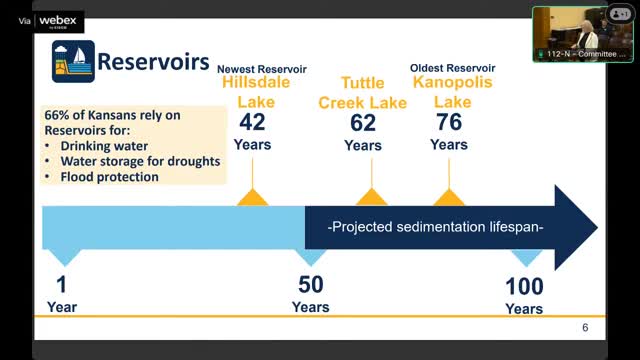Kansas leaders outline bold plan for statewide water supply and quality improvements
January 23, 2025 | Committee on Agriculture and Natural Resources, Standing, HOUSE OF REPRESENTATIVES, Committees, Legislative, Kansas
This article was created by AI summarizing key points discussed. AI makes mistakes, so for full details and context, please refer to the video of the full meeting. Please report any errors so we can fix them. Report an error »

Kansas faces significant water challenges, as highlighted in a recent meeting of the House Committee on Agriculture and Natural Resources. The committee discussed the pressing need for a comprehensive water management strategy to address the state's diverse water issues.
The oldest reservoir in the state, Kannapolis, is now 76 years old, while the youngest, Hillsdale, is 42. This aging infrastructure presents a costly problem that requires urgent attention. The committee emphasized that investing in water quality is crucial, as "an ounce of prevention is worth a pound of cure." Improving water quality can reduce future remediation costs, making it a financially sound approach.
A concerning map presented during the meeting revealed that many streams in Kansas do not meet designated quality standards. This means that while some streams may be suitable for fishing, they are not safe for swimming, indicating a significant need for cleanup efforts. The committee noted that every Kansan is affected by water issues, whether it be reservoir problems in the east or water scarcity in the west.
The proposed framework for addressing these challenges is both ambitious and practical. The vision is for every Kansan to have access to a sustainable water supply for the next 50 years, despite current limitations. The committee acknowledged that achieving this goal will require a gradual and strategic approach, akin to acclimatizing to the altitude when climbing a mountain.
In conclusion, the discussions underscored the importance of a statewide perspective on water management, recognizing that while solutions may vary by region, the need for a healthy water supply is a shared concern for all Kansans. The committee's commitment to a bold yet practical strategy aims to ensure the long-term viability of the state's water resources.
The oldest reservoir in the state, Kannapolis, is now 76 years old, while the youngest, Hillsdale, is 42. This aging infrastructure presents a costly problem that requires urgent attention. The committee emphasized that investing in water quality is crucial, as "an ounce of prevention is worth a pound of cure." Improving water quality can reduce future remediation costs, making it a financially sound approach.
A concerning map presented during the meeting revealed that many streams in Kansas do not meet designated quality standards. This means that while some streams may be suitable for fishing, they are not safe for swimming, indicating a significant need for cleanup efforts. The committee noted that every Kansan is affected by water issues, whether it be reservoir problems in the east or water scarcity in the west.
The proposed framework for addressing these challenges is both ambitious and practical. The vision is for every Kansan to have access to a sustainable water supply for the next 50 years, despite current limitations. The committee acknowledged that achieving this goal will require a gradual and strategic approach, akin to acclimatizing to the altitude when climbing a mountain.
In conclusion, the discussions underscored the importance of a statewide perspective on water management, recognizing that while solutions may vary by region, the need for a healthy water supply is a shared concern for all Kansans. The committee's commitment to a bold yet practical strategy aims to ensure the long-term viability of the state's water resources.
View full meeting
This article is based on a recent meeting—watch the full video and explore the complete transcript for deeper insights into the discussion.
View full meeting
